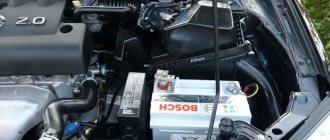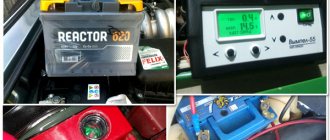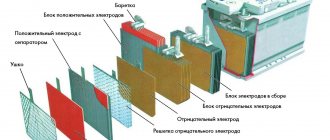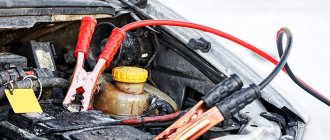About, how to charge a car battery Every car owner should know. This is necessary not only to increase the battery life, but also to ensure the safety of the entire automotive electrical system. The answer to the question of how to properly charge a battery depends on several factors, including the type of battery, its capacity, the value of current and voltage for which the battery is designed, etc. You will learn about all this if you read this material to the end.
How to properly charge a car battery
Before moving on to practical tips and recommendations, it is necessary to briefly dwell on theoretical issues. So, batteries are charged in one of two possible ways - using direct current and using constant voltage. Let's consider each of them separately.
DC charging
As the name suggests, a variable charger sets the charging current to 10% of the battery capacity (for example, a traditional 60 Ah car battery is charged at a constant current of 6 Amps). In this case, the voltage value will change during charging.
One of the disadvantages of this method is that it is necessary to periodically (about once every one or two hours) adjust the current value, which can also change. As for old maintained batteries, gas will be released from their electrolyte, and the more charged the battery is, the more intense the gas release will be. By the way, intense release of gas from the electrolyte is one of the signs of a fully charged battery.
Initially, the voltage output from the charger will be relatively low and will increase as charging progresses. At the moment when the voltage reaches 14.4 Volts, it is necessary to reduce the current by half (if it was 6 Amperes, then it must be reduced to 3 Amperes). The charging process must be carried out before intense gas evolution from the electrolyte begins. When the voltage reaches 15 Volts, the current value must be reduced by another half (to 1.5 Amperes in the example given). This must be continued until the voltage reaches a constant value and stops increasing. The second signal that the battery is fully charged will be the fact that the voltage and current values do not change for one to two hours. How long to charge can be calculated using a special calculator:
Constant voltage charging
Another charging method is to set a constant voltage on the charger. This value depends on the type of battery. When the battery is connected to the charger, the current value will be maximum (and it will be greater, the more discharged the battery is). As a rule, chargers have circuit solutions that forcefully limit the charging current to about 20...25 Amperes. This is done to preserve the functionality of both the charger and the battery. As charging proceeds, the voltage at the battery terminals approaches that supplied by the charger, and the current approaches zero. This happens according to the exponential law.
The choice of constant voltage value depends on the degree of discharge of the battery. For example, at a voltage of 14.4 Volts, the battery will be charged 75...85% in one day. At a voltage of 15 Volts - by 85...90%, and at 16 Volts - by 95...97%. To fully charge the battery in a day, you need a voltage of about 16.3...16.4 Volts. Please note that for many modern maintenance-free batteries there is an artificial voltage limit, for example, equal to 14.4 Volts. Under such conditions, it will take more than a day to fully charge the battery.
How to charge a car battery
Regardless of the type of battery, to charge it, you must use a source of constant current (constant voltage) with the ability to adjust these values. It is best to use special chargers for this, sold in car stores or markets. It is important that a charger designed for charging a battery designed for 12 Volts DC makes it possible to increase the charging voltage to 16...16.5 Volts. This is necessary in light of the fact that otherwise it will be impossible to charge a modern maintenance-free battery to its maximum capacity (100% of its capacity).
Battery (car battery)
A car battery is a vehicle's energy source that is responsible for starting the engine. The main faults are sulfation, terminal oxidation, short circuit. It is checked with a multimeter and charged with constant current or voltage. More details
First, let's consider the simplest type of battery - “antimony” (antimony is added to the plate material) and “hybrid” (antimony, calcium, and sometimes silver are added to the plate material). Accordingly, a regular charger is suitable for charging them. The charging current must be selected depending on the battery capacity, it must be 10% of its value (for example, a battery with a capacity of 60 Ah must be charged with a constant current of 6 Amps). The constant voltage value should be in the range from 13.8 to 14.5 Volts. During the charging process, the current value will drop, and this will happen according to an exponential law. This fact is also the answer to the question - how long to charge the battery. Accordingly, the duration of the loading process depends on several factors:
- battery capacity;
- the degree of its discharge;
- charger power;
- general technical condition of the battery.
The higher the charging current, the faster the battery will charge. However, in this case the probability of its discharge will also be higher. Therefore, many car enthusiasts set the current value to around 2 Amperes (approximately, depending on the capacity), and leave the battery with the charger overnight (about 6...10 hours). This approach will eliminate “overcharging,” which is very harmful to the battery, and will also provide better charging (in the future, the battery will retain its charge longer).
Please note that before the charging process, it is advisable to clean the battery terminals from plaque and rust (if any), even for preventive purposes. This will ensure better electrical contact. And after charging, it is advisable to treat the battery terminals with special means for this.
The battery charge level must be monitored regularly and the corresponding value must be checked at least once a month. Moreover, this does not depend on the time of year or the ambient temperature, although it is in the cold that problems with the battery arise much more often.
Before the charging process, it is necessary to unscrew the caps on each of the cans (for batteries being serviced), and also remove the plug in order to ensure the free release of electrolyte vapors and not to create excess pressure inside the battery. After removing the plugs, you need to check the electrolyte level in each jar. If its level is low, you need to add distilled water until it completely covers the battery plates.
Features of car battery maintenance
A set of instructions for proper maintenance of different types of car batteries. Features of servicing gel, alkaline and acid batteries Read more
It is not advisable to charge serviced batteries at home, since during the process of boiling the electrolyte, gas is released that is harmful to the human body (in high concentrations it is explosive). Accordingly, it is advisable to charge in a garage or in well-ventilated areas. As for maintenance-free batteries (the caps on the banks cannot be unscrewed), they can be charged in the apartment, since similar gas is not released under normal charging conditions.
Safety rules when charging a car battery at home
It is permissible to charge a car battery only if all safety rules are strictly observed. Charging time can be up to 10, depending on the specific device and the battery itself. In most cases they are rated at 60 amps, but there are models that deviate from the standard.
The room must be ventilated and there should be no proximity to fire or sparks. In this case, charging should be constantly monitored. During connection, the plugs are unscrewed.
It is much better to initially protect yourself and use another room to charge the battery. This could be a garage, or you should contact a professional car service, where the entire process will be carefully monitored and will ensure careful and complete charging. If such options are not considered, then you should take into account the safety rules and follow them without any discrepancies. Otherwise, there may be an accumulation of gases from the electrolyte, an explosion as a result of an accidental spark, or the process will not have any result at all and you will have to turn to professionals for charging.
When to charge the battery
Before charging the battery, you must ensure that it is truly discharged. There are several ways to do this:
- Measuring voltage at terminals . This can be done using a constant voltage voltmeter, in other words, an electronic multimeter or a pointer tester. For standard batteries used in most passenger cars, the standard voltage value is 12 V. In practice, it differs slightly from the nominal value. So, a value equal to 12.7 V tells the car owner that the battery charge level is 100%, and accordingly, there is no need to charge it. If the measured voltage is 12.2 V, then this indicates that the charge level is approximately 50%. And if the voltage drops to 11.6...11.7 V, it means that the battery is almost completely discharged and it needs additional charging.
- Measuring the electrolyte density value . However, this verification method is only possible for so-called serviceable batteries, that is, in which it is possible to reach containers with electrolyte (and add it, if necessary). To measure density, a special device is used - a hydrometer. The electrolyte density should be around 1.27 g/cm³. If it is significantly less, it means that the battery should be charged with a charger. In unattended ones there is a special window where 3 stages of density will be displayed.
- Problems starting the engine . One of the reasons why the starter does not turn, and problems arise with starting the engine, is precisely the battery discharge. This is usually accompanied by problems in the operation of other consumers of electricity in the car - lighting, operation of the audio system, and so on.
In a discharged battery, sulfation of its lead plates occurs, which leads to a sharp decrease in its service life, that is, durability.
What is the alternative?
Not everyone has advanced chargers. However, people now have a lot of different gadgets and some purchase universal chargers that allow them to charge different types of batteries. Including lead-acid. A restorative charge can be made with their help. It is quite possible that there is a special mode for this, but ample settings allow you to select it manually. At least, it is possible to set a small current of 0.03*C─0.1*C and trigger when a certain voltage is reached in them.
Is it possible to charge the battery in a car?
Many car enthusiasts, especially beginners, are interested in the question of whether it is possible to charge the battery without removing it from the car. It is important to separate concepts here. As for its physical removal (for example, moving it closer to the charger), charging can be carried out directly on its seat. However, if we are talking about disconnecting car terminals, then this must be done! You especially need to disconnect the negative terminal, although both are better. This is due to the fact that even in a situation where the engine is not started, the electric current from the battery still passes into the electrical system of the car, powering the corresponding elements.
Firstly, during charging, some of the electrical energy from the battery will go into the system. This will naturally increase charging time. Secondly, there is always a risk of a power surge or other similar troubles, which can negatively affect the condition of the elements of the car's electrical system. This is especially true for expensive cars (business and premium class), the design of which has a lot of built-in electronics. She will be at risk.
Bottom line
The battery is an important part in a car. You cannot treat it negligently, so as not to encounter problems because of it. Today you learned how to charge a car battery with a charger and everything that is somehow related to this issue. Treat your battery correctly, check it periodically and change it if necessary.
The average lifespan of a car battery is about five years. There are especially high-quality batteries that can last up to eight years. If you do everything correctly and approach the issue wisely, then you will never be faced with unpleasant surprises even on the frostiest morning, when you are rushing about your most important and urgent matters. After all, as a rule, a problem with the battery occurs precisely under such circumstances.
How to charge a calcium battery
Calcium batteries (also designated Ca-Ca) are practically maintenance-free and are relatively new devices on the automotive market. They have many advantages (high starting currents, significant capacity, the electrolyte does not evaporate from them), but they also have disadvantages. One of them is that if they are charged incorrectly, then after 3…4 deep discharge cycles their capacity decreases significantly. Accordingly, the charging process is critically important for them.
Since calcium batteries are made using a special technology, their charging process is special. So, for this it is necessary to use chargers capable of delivering direct electric current with a voltage range of 16.1...16.5 Volts. Accordingly, if any power supply produces a maximum voltage value of 14.8 Volts, and then the electronics “cut it off”, then in this case the battery will be charged to 45...50% of its capacity. If the same value is 15.5 Volts, then charging will occur at 70...80% of the capacity. Accordingly, you will never reach a normal 100% charge (an excellent charger for charging calcium batteries is the Orion Vympel-55 with a programmable cycle).
It is interesting that the electric generators of modern passenger cars are not able to produce such a high voltage. Usually it does not exceed 15 Volts. Accordingly, a calcium battery cannot be charged when installed in a car. The generator simply does not allow it to discharge. However, given the harsh domestic winters, cold and harsh operating conditions can do their dirty work and discharge the calcium battery. Therefore, it needs to be recharged periodically (about once a month)! However, to do this you need to have a charger with programmable modes. You need to recharge according to the following algorithm:
- Set the voltage on the charger to 16.1 Volts. The current value will be equal to 10% of the battery capacity (for example, if the battery capacity is 60 Ah, then the current value will be 6 Amperes).
- In this mode, you need to charge the battery until the charging current drops to 0.5 Ampere. This can take a few minutes or several hours, it all depends on the discharge of the battery, its capacity and general technical condition.
- Set two modes. Upper - voltage value 16.1 Volts and 3 Amps. Lower - 13.2 Volts and 0 Amperes.
- Arrange a so-called “swing”. Their meaning is that at a current of 3 Amps the voltage value gradually increases to a value of 16.1 Volts. When this value is reached, the current disappears (equal to zero), and the voltage smoothly drops to 13.2 Volts. Next, the current is again set to 3 Amperes and the voltage again rises to 16.1 Volts. Then everything is repeated.
- As the battery charges, the time intervals for switching modes will decrease. Initially, the process of voltage increase will take several tens of minutes, and the decrease time will be very fast. However, over time, the opposite situation will occur. That is, a voltage drop to 13.2 Volts will last for minutes, and its increase to 16.1 Volts will take less than one minute. This situation indicates that the calcium battery is fully charged.
We use the power supply
First, let's look at a method that uses a twelve-volt power supply and a resistor of about 500 Ohms. To push, you need to short-circuit the battery with the block for two to three minutes, connecting the negative of the device to the negative of the block, and the plus to the positive, respectively, but through a resistor (!).
The supplied voltage must be controlled. Use a tester or voltmeter for this purpose - the supplied voltage should be about 4.5 Volts.
A smartphone battery usually has 3 contacts – one “+”, the other (-), and the middle one is not useful to us. Be very careful not to mix them up when connecting the power supply. If the contacts are not marked, you can determine their polarity with a multimeter - some small voltage should remain on them.
“Starting the battery with a fan”
IMPORTANT. A rapidly occurring discharge of the device may indicate a high (increased) internal resistance - it is no longer suitable for use.
How to charge a gel battery
Gel batteries are another type of modern battery that has advantages over traditional acid batteries (they are designated GEL). Basically, they are used as power supply for car multimedia systems and batteries for scooters, motorcycles, and ATVs. They can also be used in uninterruptible power supplies (UPS) for computers, gas boilers and other household appliances. The advantages of gel batteries include:
- high current output, even in low charge mode (about 20...30% of the nominal value);
- a large number of recharge cycles (up to one thousand or even more, depending on the specific model and operating conditions);
- minimum self-discharge current (this allows you to keep the battery in a charged state for a long time, even in unfavorable operating conditions for it, it can only lose about 20% of its charge per year!!!);
- The gel battery can be stored completely discharged even at negative ambient temperatures.
As for the disadvantages, gel batteries have only two of them:
- high price compared to traditional acid batteries with the same technical parameters;
- A gel battery really does not like increasing voltage (overcharging), and under such conditions its capacity is significantly reduced and the overall service life is reduced.
Many car enthusiasts who use such batteries are interested in the question of how to charge a gel battery? In fact, there are few differences from charging traditional batteries.
- For charging, a conventional charger is used with the ability to adjust the value of the current and voltage it produces.
- The current value is selected depending on the battery capacity. It should be 10% of it. For example, for a battery with a capacity of 60 Ah, the charging current should be 6 Amperes. In extreme cases, for example, if you need to charge the battery quickly, then it is allowed to take 30% of the capacity. That is, in our case it will be 18 Amperes.
- For a gel battery, it is important not to overdo it with the voltage value, that is, you should not set its value too high. As a rule, the limit value in this case will be 14.5...15 Volts (additional information should be checked on the sticker on the battery case).
- The maximum value of the permissible charging current is designated as max initial current . The charging current must not be allowed to increase above the corresponding value.
- The charging time of a gel battery depends on the charging current. To calculate it, you need to divide the capacitance value by the current value. If the current was chosen at 10% of the capacity, then the charging time will be the same 10 hours. If the current is lower, then the time will be longer. In order to exclude the possibility of overcharging (which is very harmful for a gel battery!) it is better to use special electronic chargers for this, which will automatically select both the charging current and the time period for this.
The reason that the battery is destroyed when the voltage increases is that under these conditions the gel, which acts as an electrolyte, begins to melt. And the higher the voltage, the stronger the melting. And the longer the time of excessive recharging, the worse it is for the electrolyte gel.
If the gel battery is serviceable, then it is necessary to unscrew the plugs from its cans (containers) so as not to create excess pressure inside it. The charger probes must be connected to the corresponding terminals on the battery (observing polarity). Next, you need to set the appropriate current and voltage values on the charger. As the battery charges, the voltage in it will increase. It should not be allowed to go beyond the cycle use . If this happens for a short time, then you need to reduce the current in order to reduce the voltage. Under such conditions, the battery can usually be fully charged in 10...12 hours.
Often the label will indicate a Standby Use , which indicates at what voltage the battery can be in standby mode. The manufacturer implies that the battery can be stored for a long time without recharging, but to maintain its performance without load, it must be periodically recharged with a low voltage. Typically this range is around 13.5...13.8 Volts. Failure to comply with this requirement will lead to irreversible consequences, in particular, rapid loss of battery capacity and rapid failure.
The optimal solution for charging a gel battery is to use special electronic chargers that will automatically control the value of the charging current and voltage, and, if necessary, limit them. In addition, such chargers select the charging mode based on the degree of discharge of the battery, as well as external factors such as ambient temperature. There are chargers on the market that are specifically designed to work with gel batteries. In particular, they have a temperature compensation function and a function for controlling the charging process in stages in automatic mode.
Please note that if a gel battery is installed on the machine, then it is imperative to periodically check the functionality of the voltage relay on the generator. If it fails, the battery can fail in literally a matter of hours. You can buy terminals with a relay regulator as additional protection.
Manufacturers
This is a moment that also cannot be ignored, as it is important. Experienced car enthusiasts recommend giving preference to famous brands; they cost a little more, but this is a certain guarantee of high quality. It can be said that when it comes to car batteries, a stingy person can pay twice. This rule holds true, as confirmed by numerous reviews and opinions of authoritative people in the automotive field.
If we talk about foreign brands, it is worth highlighting Varta and Bosch. Both brands come from Germany. The batteries from these manufacturers are not the cheapest in the segment, but are distinguished by high quality workmanship and a long service life.
If we talk about domestic manufacturers, then it is worth focusing on “Titan” and “Akom”. These companies make very high quality products. There is an opinion among car enthusiasts that Akom batteries are generally better than even famous imported analogues. This opinion is not taken from heaven, this is real experience and tests of reputable companies in this industry.
Of course, the list of worthy examples does not end with four brands. We just mentioned four brands that stand out from the crowd of companies specializing in the production of car batteries.
Therefore, before buying a new battery, you should ask people who have already been through a battery replacement situation, compare manufacturers, pricing policies, characteristics, and read reviews. Of course, the best adviser in this situation is experience, preferably personal or people you completely trust.
In general, there is a trend that is definitely applicable to foreign-made cars. It lies in the fact that the battery that is supplied with the vehicle from the manufacturer lasts the longest. From here we can draw some not entirely good conclusions about our stores and their integrity.
How to charge a hybrid battery
In hybrid batteries, one part of the plates is made using “antimony” technology, and the other is made using “calcium” technology (sometimes with the addition of silver). The battery is low maintenance, but it still has plugs. Accordingly, it is necessary to check the electrolyte level once every two to three months and, if necessary, add distilled water to it. Among the advantages, it is worth noting its resistance to deep discharge and the ability to produce high starting current. As for the price, it is acceptable, and approximately two times less than calcium.
As for the charging process, it is standard and not difficult. So, it is necessary to charge with a current whose value is 10...30% of the capacitance value. As mentioned above, for 60 Ah the current should be 6 Amperes (if you need to charge faster, you can increase it to 18 Amps). It would be optimal to set the current value to 2 Amperes. The voltage value will be in the range of 13.8...14.2 Volts. The charging end signal will be a voltage value of 14.2 Volts and a current value of 0.3...0.5 Amperes.
You cannot set high charging currents, otherwise the electrolyte will boil, which is extremely harmful for the battery plates; they heat up and the active mass may fall off from them.
A special feature of a hybrid battery is that in the summer it is necessary to regularly check the electrolyte level. This is due to the fact that, unlike its old “brothers”, such a battery produces a higher operating voltage. And if in winter this only helps to start the engine without problems, then in summer it turns into free energy. This is fraught with the fact that the electrolyte may boil and begin to evaporate, and the acid concentration increases. Because of this, the plates heat up and become exposed, thereby becoming damaged. Therefore, in the summer, in addition to recharging, it is necessary to monitor the electrolyte level in the hybrid battery banks.
Using charging and discharging devices
With this method of pushing, you first need to turn off the protection system - this is the controller that turned off our power supply. It needs to be unsoldered.
Then the battery (without a controller) is connected to a charge-discharge device, in this case a Turnigy Accucell 6. It performs the function of monitoring the parameters of the ongoing recovery charging process. The “TYPE” button selects the charging program.
The selection of charge parameters for various types of batteries is carried out using several presses of the “START” key. In addition, the value for the flowing current must be determined and set. The value is selected using the “+” and “-” buttons. And the indicator itself is calculated as ten percent of the nominal capacity.
When the maximum capacity value is reached, the mode changes - the process switches to the “voltage stabilization” mode. A sound signal will indicate the end of charging. And the message “FULL” will appear on the monitor.
How to charge an AGM battery
New batteries made using AGM technology are confused by many car enthusiasts with gel batteries (denoted as GEL). In fact, these are two different types of batteries. One of the advantages of such batteries is high starting currents (up to 500...900 Amperes), which allows you to start any engine in cold weather without any problems. Another advantage of an AGM battery is faster charging (about three times faster). And it charges perfectly from a car generator. And its service life is 3...5 years longer than that of a conventional acid battery.
As for charging AGM batteries, there are three options. In particular:
- Charge, accumulation, storage . The charging process can be carried out directly on the car or using a charger. In this case, the voltage value will be in the range of 14.2...14.8 Volts (but not more than 15.2 Volts, you need to further clarify in the instructions), the current strength will be 10...30% of the capacitance value. Energy is accumulated after deep discharge. The voltage is similar - 14.2...14.8 Volts, and the current is 10% of the capacity (no more!). In storage mode (for example, long-term storage in a warehouse or garage), the charging voltage should be within 13.2...13.8 Volts, and the current value should be 5...10% of the capacity value.
- Charging and storage . This is the most common option and is recommended by most manufacturers. For charging, the voltage is 14.2...14.8 Volts, and the current is 10...30% of the capacity. For storage, the voltage will be 13.2…13.8 Volts.
- Loading . Some manufacturers do not indicate the storage mode, but only provide information about charging conditions. They are identical to those given above - the voltage is 14.2...14.8 Volts, and the current is 10...30% of the battery capacity.
A few words about chargers. As with gel batteries, current and voltage levels must be closely monitored. Therefore, it is advisable to purchase an electronic charging unit in advance, preferably with two modes. This will not only minimize the participation of the car owner in the charging process, but will also ensure safe and efficient charging. If you decide to buy a mechanical charger, you will need to manually carefully monitor and adjust the current and voltage values.
Home storage
Some car enthusiasts who usually drive domestically produced cars take the battery home every evening. There they recharge it or simply keep it warm, and every morning they are confident in their battery. Of course, this is correct, but not entirely. At a minimum, the car remains without an alarm system at this moment. And in general, where has it been seen in the modern world to constantly carry a heavy battery with you? Isn't it easier to buy yourself a decent battery and solve the problem once for several years? Of course, everyone answers this question themselves.
How to charge a maintenance free battery
Many modern batteries are maintenance-free. This means that they cannot check the electrolyte level and the condition of the plates. In general, the process of charging maintenance-free batteries is not much different from a similar procedure with old batteries. Charging can be done with either constant current or constant voltage. The best option would be to use an electronic automatic charger for this, for example, with a charging indicator light (a green light indicating the end of charging). It will not only make the car owner’s work easier, but will also ensure the correct current and voltage values, as well as charging time.
However, if you use a mechanical charger, then calculating the charging time is important in this context. To do this, you need to calculate the degree of its discharge. A voltage value at the battery terminals of 12.7 Volts indicates a 100% battery charge. If the same value is equal to 11.7 Volts (it could be lower, but this will already be a deep discharge, which is harmful for many batteries), then it can be taken as 0%. Accordingly, for example, a voltage of 12.2 Volts will indicate a charge of 50% capacity.
The optimal charging current is 10% of the capacity. In the example repeatedly given above, this would be 6 Amps for a battery with a capacity of 60 Ah. For example, if the measured voltage at the terminals is 12.2 Volts, that is, the battery is 50% discharged, then this means that to fill its capacity we need to supply 30 Ah. Therefore, 30 Ah must be divided by the current value of 6 Amps, resulting in 5 hours. Theoretically, you can apply all 30 Amps to reduce the time to one hour. However, this should not be done as it will kill the battery. And you will have to change it sooner than you would like.
It is important to understand that overcharging is harmful for any battery. That is, for example, what will happen if you wait not 5 hours, as in the previous example, but 7 or 10? In this case, the level of capacity and charging will not change, but the process of boiling of the electrolyte will begin with its evaporation. And if it can be topped up in a serviced battery, then this cannot be done in an unserviced one; accordingly, such a situation cannot be allowed either! The boiled electrolyte will evaporate through the safety release valve when critical pressure is reached inside the battery cans. However, its body will remain intact (it will not explode, as many car enthusiasts think). But a low electrolyte level will reduce the battery capacity and reduce its overall operating life. According to the instructions, recharging is allowed for a maximum of 15...30 minutes.
Preparing to charge
To make the process go smoothly, follow a few simple steps.
- Remove the device from the car;
- Make sure the battery is dead. Check the special indicator. If there is no indicator, use a tester;
- Remove dirt from the body and at the same time inspect it for damage;
- Check the electrolyte level. Normally it covers the plates. If the electrolyte is too low, add distilled water;
- Check the ventilation, unscrew the caps from the cans. In the process, vapors will be formed, which should freely penetrate outside.
Important! If the battery is damaged, do not use it or try to charge it - replace it with a new one.











